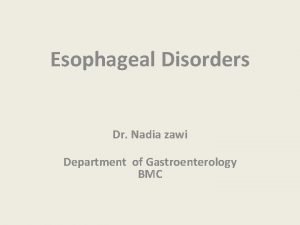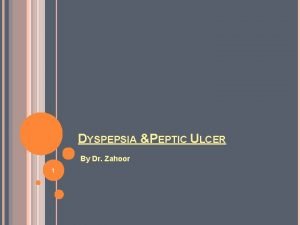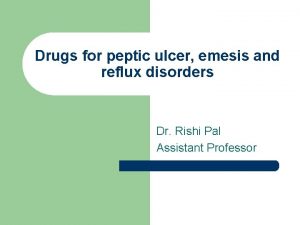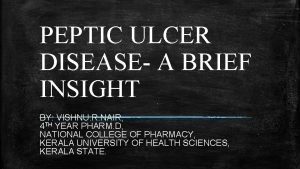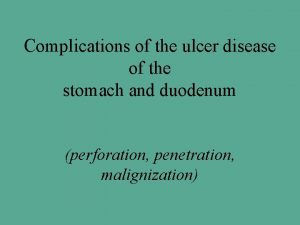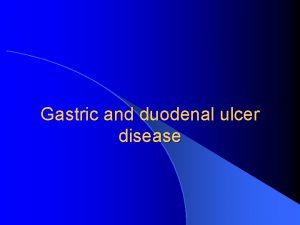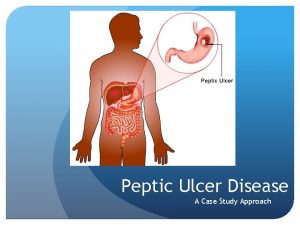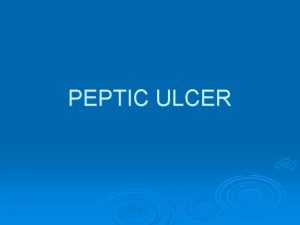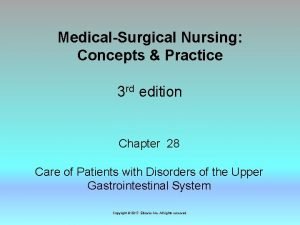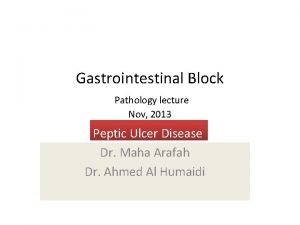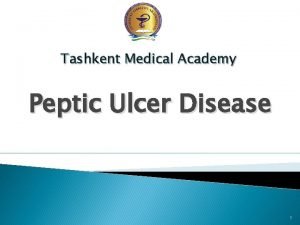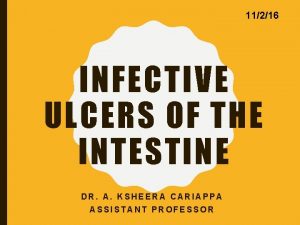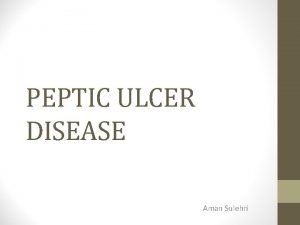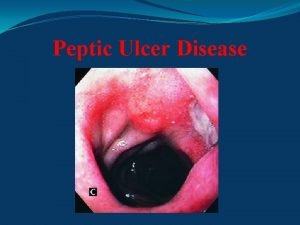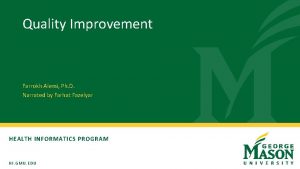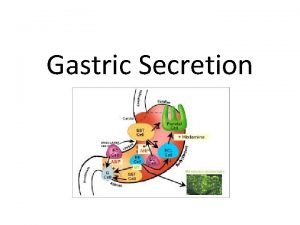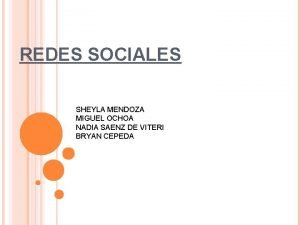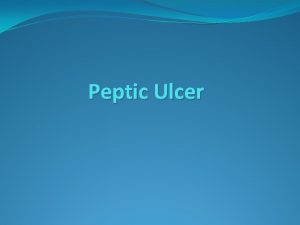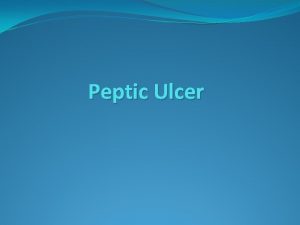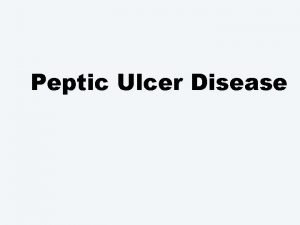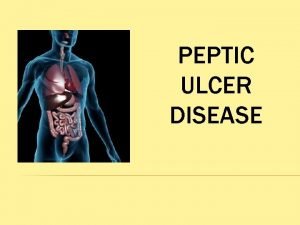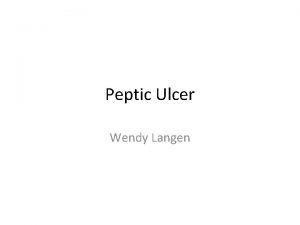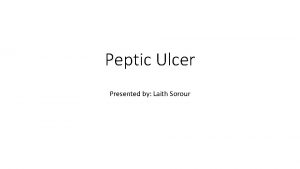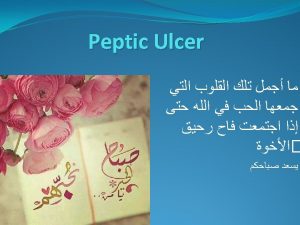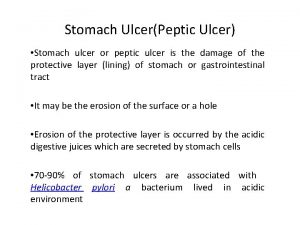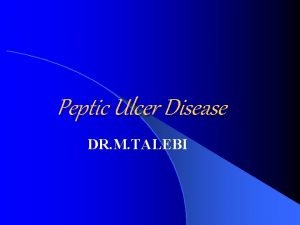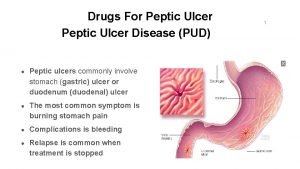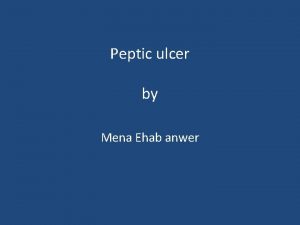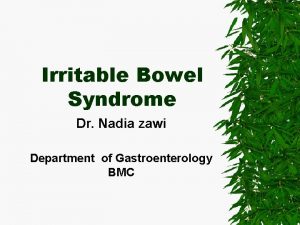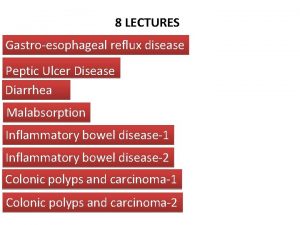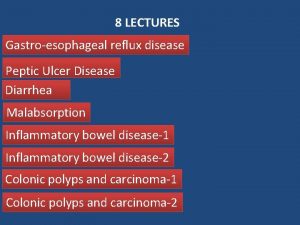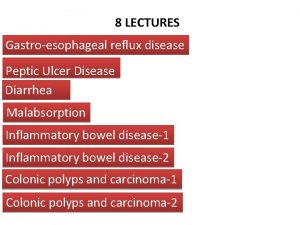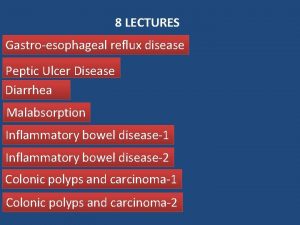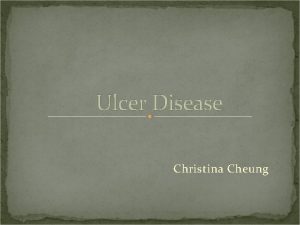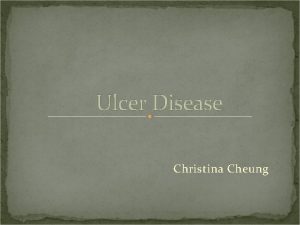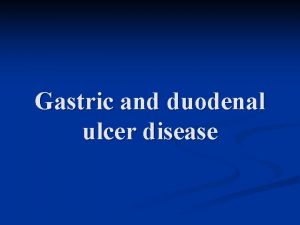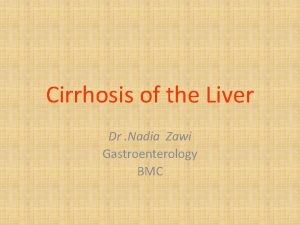Peptic Ulcer Disease Dr Nadia farhat zawi Department























- Slides: 23

Peptic Ulcer Disease Dr. Nadia farhat zawi Department of gastroenterology BMC

objectives • • Definition Types Epidemiology& etiology Clinical picture Differential diagnosis Diagnosis & complications Treatment

Definition • A break in superficial epithelial cells penetrating down to muscularis mucosa. • A circumscribed ulceration of the gastrointestinal mucosa occurring in areas exposed to acid and pepsin and most often caused by Helicobacter pylori infection.

Peptic Ulcers: Gastric & Dudodenal

Comparing Duodenal and Gastric Ulcers

Duodenal Ulcers • Incidence: duodenal are 4 x as common as gastric ulcers • most common in middle age – peak 30 -50 years • • • Male to female ratio— 4: 1 hereditory: 3 x more common in 1 st degree relatives more common in patients with blood group O associated with increased serum pepsinogen Helicopacter pylori( H. Pylori) infection common – up to 95% • smoking is twice as common

Gastric Ulcers • common in late middle age – incidence increases with age • Male to female ratio— 2: 1 • More common in patients with blood group A • Use of NSAIDs - associated with a three- to four-fold increase in risk of gastric ulcer • Less related to H. pylori than duodenal ulcers – about 80% • 10 - 20% of patients with a gastric ulcer have a concomitant duodenal ulcer

Etiology • • • The most important contributing factors are H pylori. NSAIDs. acid, and pepsin hypersecretion. Additional aggressive factors include: smoking. ethanol. bile acids. aspirin, steroids. and stress.

Clinical features • Symptoms: • Pain—”gnawing”, “aching”, or “burning” – – – Duodenal ulcers: occurs 1 -3 hours after a meal and may awaken patient from sleep. Pain is relieved by food, antacids, or vomiting. Gastric ulcers: food may exacerbate the pain while vomiting relieves it. • Nausea, vomiting, belching, dyspepsia, bloating, chest discomfort, anorexia, hematemesis, &/or melena may also occur. – nausea, vomiting, & weight loss more common with Gastric ulcers

• • Examination : Epigastric tenderness. Guaic-positive stool resulting from occult blood loss. Succussion splash resulting from scaring or edema due to partial or complete gastric outlet obstruction. – A succussion splash describes the sound obtained by shaking an individual who has free fluid and air or gas in a hollow organ or body cavity. – Usually elicited to confirm intestinal or pyloric obstruction. – Done by gently shaking the abdomen by holding either side of the pelvis. A positive test occurs when a splashing noise is heard, either with or without a stethoscope. It is not valid if the pt has eaten or drunk fluid within the last three hours.

Differential Diagnosis • • • Neoplasm of the stomach Pancreatitis Pancreatic cancer Diverticulitis Nonulcer dyspepsia (also called functional dyspepsia) Cholecystitis Gastritis GERD MI—not to be missed if having chest pain

Diagnostic Plan • Stool for fecal occult blood • Labs: CBC (R/O bleeding), liver function test, amylase, and lipase. • H. Pylori can be diagnosed by urea breath test, blood test, stool antigen assays, & rapid urease test on a biopsy sample. • Upper GI Endoscopy: Any pt >50 yrs with new onset of symptoms or those with alarm markings including anemia, weight loss, or GI bleeding. – Preferred diagnostic test b/c its highly sensitive for dx of ulcers and allows for biopsy to rule out malignancy and rapid urease tests for testing for H. Pylori.

H. Pylori Urease producing, gram negative bacillus. Developing countries. Infection increases with age. Infects mucosa of stomach > inflammatory response > gastritis > increased gastrin secretion > damage to mucosa > ulceration • Increased risk of developing gastric adenocarcinoma • •

Treatment Plan: H. Pylori • Medications: Triple therapy for 14 days is considered the treatment of choice. – Proton Pump Inhibitor + clarithromycin and amoxicillin • Omeprazole (Prilosec): 20 mg PO bid for 14 d or Lansoprazole (Prevacid): 30 mg PO bid for 14 d or Rabeprazole (Aciphex): 20 mg PO bid for 14 d or Esomeprazole (Nexium): 40 mg PO qd for 14 d plus Clarithromycin (Biaxin): 500 mg PO bid for 14 and Amoxicillin (Amoxil): 1 g PO bid for 14 d • Can substitute Flagyl 500 mg PO bid for 14 d if allergic to Penicillin. – In the setting of an active ulcer, continue proton pump inhibitor therapy for additional 2 weeks. • Goal: complete elimination of H. Pylori. Once achieved Reinfection rates are low. ( Compliance!)

Evaluation/Follow-up/Referrals of PUD • H. Pylori Positive: retesting for tx efficacy • Urea breath test—no sooner than 4 weeks after therapy to avoid false negative results • Stool antigen test—an 8 week interval must be allowed after therapy. • H. Pylori Negative: evaluate symptoms after one month. Patients who are controlled should cont. 2 -4 more weeks. • If symptoms persist then refer to specialist for additional diagnostic testing.

Treatment Plan: Not H. Pylori • Medications—treat with Proton Pump Inhibitors or H 2 receptor antagonists to assist ulcer healing – H 2: Tagament, Pepcid, Axid, or Zantac for up to 8 weeks – PPI: Prilosec, Prevacid, Nexium, Protonix, or Aciphex for 4 -8 weeks.

Lifestyle Changes • Discontinue NSAIDs and use Acetaminophen for pain control if possible. • Acid suppression--Antacids • Smoking cessation • dietary restrictions if certain foods are associated with problems. • Stop Alcohol • Stress reduction

Prevention of PUD • Consider prophylactic therapy for the following patients: – Pts with NSAID-induced ulcers who require daily NSAID therapy – Pts with a history of PUD or a complication such as GI bleeding – Pts taking steroids or anticoagulants or patients with significant comorbid medical illnesses • Prophylactic regimens that have been shown to dramatically reduce the risk of NSAID-induced gastric and duodenal ulcers include the use of a prostaglandin analogue or a proton pump inhibitor. – Misoprostol (Cytotec) 100 -200 mcg PO 4 times per day – Omeprazole (Prilosec) 20 -40 mg PO every day – Lansoprazole (Prevacid) 15 -30 mg PO every day

Complications • Perforation & Penetration—into pancreas, liver and retroperitoneal space • Peritonitis • Bowel obstruction, Gastric outflow obstruction, & Pyloric stenosis • Bleeding--occurs in 25% to 33% of cases and accounts for 25% of ulcer deaths. • Gastric Cancer ( more common with gastric ulcers).

Surgery • People who do not respond to medication, or who develop complications: – Vagotomy - cutting the vagus nerve to interrupt messages sent from the brain to the stomach to reducing acid secretion. – Antrectomy - remove the lower part of the stomach (antrum), which produces a hormone that stimulates the stomach to secrete digestive juices. A vagotomy is usually done in conjunction with an antrectomy. – Pyloroplasty - the opening into the duodenum and small intestine (pylorus) are enlarged, enabling contents to pass more freely from the stomach. May be performed along with a vagotomy.

• • Case : A 65 -year-old man has a 6 -week history of gnawing epigastric pain, and nausea but no vomiting. The pain is slightly improved with meals and antacids. No melena, chills, or fever but has lost 3. 6 kg over the past 4 weeks. Medical history includes hypertension, treated with a thiazide diuretic, and degenerative joint disease of both knees, treated with ibuprofen. Abdominal examination discloses mild epigastric tenderness to palpation Hemoglobin is 11 g/Dl *What is the most likely diagnosis? * next step?

Summary • The most common finding in patients with peptic ulcer disease is gnawing epigastric pain. (location & pattern ) • Approximately 90% of patients with peptic ulcers either are infected with Helicobacter pylori or are taking non steroidal anti-inflammatory drugs, or both. • Patients may present with a peptic ulcer complication without having antecedent ulcer symptoms.

Thank you
 Beniegn
Beniegn Peptic ulcer disease
Peptic ulcer disease Triple therapy for peptic ulcer disease
Triple therapy for peptic ulcer disease Dicycloamine
Dicycloamine Triple therapy for peptic ulcer disease
Triple therapy for peptic ulcer disease Peptic ulcer disease
Peptic ulcer disease Patient counselling for peptic ulcer disease
Patient counselling for peptic ulcer disease Tripple therapy
Tripple therapy Stages of peptic ulcer perforation
Stages of peptic ulcer perforation Modified johnson classification of peptic ulcer
Modified johnson classification of peptic ulcer Proton pump inhibitor
Proton pump inhibitor Stomach ulcer definition
Stomach ulcer definition Acholorhydria
Acholorhydria Peptic ulcer diseas
Peptic ulcer diseas Peptic ulcer morphology
Peptic ulcer morphology Stomach ulcer symptoms
Stomach ulcer symptoms Ulcer niche
Ulcer niche Tuberculous ulcer and typhoid ulcer
Tuberculous ulcer and typhoid ulcer Niche and notch in gastric ulcer
Niche and notch in gastric ulcer Duodenal ulcer vs gastric ulcer
Duodenal ulcer vs gastric ulcer Farhat fazelyar
Farhat fazelyar Communicable disease and non communicable disease
Communicable disease and non communicable disease Stomach cells secrete
Stomach cells secrete Nadia wemboluan redes sociales
Nadia wemboluan redes sociales
